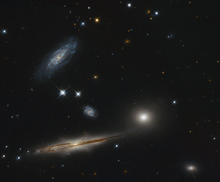HCG 87
HCG 87 is a compact group of galaxies listed in the Hickson Compact Group Catalogue. This group is about 400 million light-years away [2] in the constellation Capricornus. The group distinguishes itself as one of the most compact groups of galaxies, hosting two active galactic nuclei and a starburst among its three members, all of which show signs of interaction.[3] This interaction, which astronomers have called visually, and scientifically, intriguing[4] is being examined to understand the influence of active nuclei on star formation histories.
| HCG 87 | |
|---|---|
 Galaxy Group HCG 87 | |
| Observation data (Epoch ) | |
| Constellation(s) | Capricornus |
| Right ascension | 20h 48m 11.9ss[1] |
| Declination | −19° 50′ 35″[1] |
| Number of galaxies | ~5 |
| Distance (co-moving) | 400 million |
| Other designations | |
| None | |
Members
| Name | Type[5] | R.A. (J2000)[5] | Dec. (J2000)[5] | Redshift (km/s)[5] | Apparent Magnitude[5] |
|---|---|---|---|---|---|
| HCG 87a | S0 pec | 20h 48m 15.0s | −19° 50′ 58″ | 8443 ± 14 | 15.3 |
| HCG 87b | SA(r)0 pec | 20h 48m 10.9s | −19° 51′ 23″ | 8740 ± 20 | 15.4 |
| HCG 87c | Sb | 20h 48m 12.0s | −19° 49′ 56″ | 8914 ± 7 | 16.1 |
| HCG 87d | Sd | 20h 48m 12.8s | −19° 50′ 46″ | 10200 ± 160 | 17.8 |
gollark: Oh. You destroyed the city's power grid. I see.
gollark: Huh?
gollark: I could say the same to you.
gollark: How to win at chess:- find what chess engine your opponent is using- find a vulnerability in it- send them a move which crashes it- ???- profit
gollark: machine > human in many areas
External links
References
- "NASA/IPAC Extragalactic Database". Results for HCG 87. Retrieved 2006-10-19.
- This redshift corresponds to a distance of 120Mpc or 400 million light years (using H0 = 75km/s/Mpc and q0 = 0.1). At the distance of the group, this corresponds to a group diameter of 52kpc, i.e., the group is approximately 170,000 light years across.
- Noll, Keith. 07/1999. "Hubble Heritage observations of Hickson Compact Galaxy Group 87".
- English, J. et al. 05/2000. "A Minuet of Galaxies: Hickson Compact Group 87 as Viewed by the Hubble Space Telescope". American Astronomical Society, 195th AAS Meeting, #136.04; Bulletin of the American Astronomical Society, Vol. 32, p.884.
- "NASA/IPAC Extragalactic Database". Results for various galaxies. Retrieved 2006-10-19.
This article is issued from Wikipedia. The text is licensed under Creative Commons - Attribution - Sharealike. Additional terms may apply for the media files.